|
So Long, Dear
Friend! I Hardly Knew You!
I met Jamie
Scarlett in 1994 on the Black Isle of Scotland when my wife Susan and I were
guests for lunch at Newhall, the home of our Clan Shaw Chief, John Shaw of
Tordarroch. Jamie and his lovely wife Meta, long-time friends of our hosts,
John and Sylvia Shaw, appeared shortly after our arrival. I remember driving
back to our hotel, Culloden House, impressed with Jamie’s dry wit and Meta’s
knowledge of the Kingussie area of Inverness-shire.

Jamie Scarlett at
the Tomatin Inn just off the A9 south of Inverness.
During our
visits to Scotland through the years, we were guests in the home of Jamie
and Meta at Milton of Moy on several occasions. The warm fire in the hearth
and the afternoon chats in their living room have been a source of joy all
these years and will long be remembered, as well as the treats of venison,
scones and homemade jellies. Jamie’s favorite chair, placed in front of the
fireplace, was surrounded by three walls of his cherished books on tartans,
some of them rare, first editions.
In addition we
spent many a night around a dinner table at “our home away from home”, the
Dunain Park Hotel, formerly an old clan hunting lodge, just off A-82, a few
miles out from Inverness. The proprietors, Edward and Ann (nee Shaw) Nicoll,
always saw to it that we had a private parlor with a peat fire blazing in
the hearth before dinner in which to entertain Jamie and Meta and, from time
to time, the Shaws of Tordarroch would joined us for the evening. I never
tired of conversation with Jamie. When he spoke you listened. He was not a
man who kept talking when interrupted. His views about life, authors, books,
local news and history, and yes, politicians, were always good for a few
laughs. In a battle of wit, Jamie was a man you did not want to engage if
you were unarmed, since he did not suffer fools lightly!
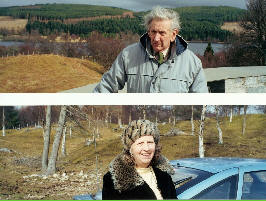
Top photo is of
Jamie at the Macintosh Memorial at Moy.
Below is Jamie's beloved Meta in her favorite fur hat.
Jamie remained
Jamie! I cannot imagine writing a chapter on the tartan, but here was a man
whose hand penned many books on the subject. Tordarroch, some years later,
faxed me news that “Queen Elizabeth has given to Jamie Scarlett the award in
this year’s Honours List of MBE – Member of the Most Noble Order of the
British Empire – for his contributions to the history and study of tartan.”
He never spoke of this honor in my presence, and I never noticed he needed
a larger hat size.
In a
conversation with Jamie about tartan, I was a bit critical of R. R. McIan’s,
classic book entitled The Clans of the Scottish Highlands
regarding the mistakes McIan made about the Shaw tartan. Jamie asked if he
could write an article for Clach na Faire, the Clan Shaw
newsletter which I edited at that time. His article was entitled “Don’t
Shoot McIan – He’s Doing His Best!” I learned a deep lesson, and even
today I try to recall his words when it would be so easy to blast away at an
author or editor of a book I am reviewing. Thanks Jamie, for those words of
wisdom.
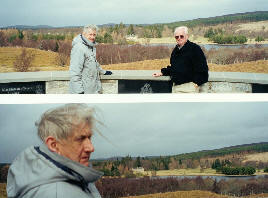
Top: (L-R) Jamie
Scarlett and Frank Shaw at the Macintosh Memorial with Moy Hall, home of the
Chief of the Macintosh Clan, in the background.
Second photo: Close-up of Jamie overlooking the grounds of Moy Hall,
probably contemplating another tartan for someone.
One of the
stories Jamie regaled us with had to do with the stones placed on the grave
of the progenitor of Clan Shaw, Shaw Mor, at St. Tuchaldus, the old (ruined)
church in the parish of Rothiemurchus, a short distance from Aviemore. These
cheese-shaped gravestones have been in position since Shaw Mor’s death in
1405 and remained undisturbed until a few years ago when they were
vandalized. The number was originally five but now only four remain. The
stones would be tossed into the River Spey by young men tempting tradition
that something bad would happen for disturbing the stones. But the young men
only played their pranks after they had fortified their nerves with enough
whisky. The stones had to be retrieved by those willing to risk their lives
in the River Spey, usually local law enforcement personnel. To protect the
stones on the grave, Susan and I had a wrought-iron mortsafe made by a
blacksmith on the Black Isle. During the days of body snatchers, a mortsafe
was necessary to protect graves of bodies that were sold to the medical
school in Inverness. Jamie and Meta joined us for the dedication of the
mortsafe by our clan chief there in the Rothiemurchus cemetery. As Jamie
walked around the mortsafe for the first time, he nodded approvingly and
said, “I have a few more stories to tell you.”
When David Shi,
President of Furman University in Greenville, South Carolina, commissioned
me to have a tartan made for our university, Jamie was the first and only
person to come to mind, so the Shis and Shaws made a pilgrimage to Milton of
Moy to ask Jamie’s assistance. That beautiful purple, white and black tartan
designed by Jamie and first made on the little loom in his humble croft, is
now worn in one form or another by university students, professors, staff,
and graduates.
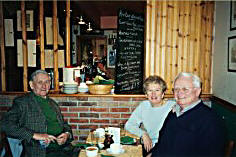
Group shot of Jamie
and Susan & Frank Shaw at the Tomatin Inn just off the A9 south of
Inverness.
Upon receiving
a few Furman mementoes from President Shi, Jamie wrote to me: “The Furman
book, polo shirt, and golf towel came this afternoon. Lovely products,
lovely book, and a lovely place. I can feel the atmosphere coming off the
pages: to be there for three years would be an education quite apart from
learning anything. Certainly it will be a pleasure to be associated, however
remotely, with such an establishment.” He went on to say in another email
that “it is always good to hit a bull’s-eye, and the Furman tartan seems to
have done that. I wish it all (the tartan items) good fortune.”
Of all the good
meals shared with Jamie and Meta, we really enjoyed the fish and chips at a
delightful local inn, across the A-9, not far from Jamie’s home. In an
article for our clan newsletter, I had written that the fish and chips at
this particular inn were “in my opinion, the best fish and chips in
Scotland”. Sadly that statement was not true on my next visit and declined
even more when the inn went through several different owners. We stopped
going during our visits to the auld country, but just last year Jamie gave
me an update on the inn with these happy words: “I had fish and chips at the
Inn a fortnight ago and can report that it is up to standard.”

(L-R) Frank Shaw,
Scott Shaw, Jamie Scarlett, Susan Shaw and Denise Shaw having lunch at cafe
in the old school house on the Rothiemurchus Estate.
Jamie and I
swapped many emails over the years, birthday cards, and small gifts. When I
saw his name pop up on my email screen, I found myself smiling because I
knew I was in for a treat or two. I treasure his emails today and will
always prize them as I do my memories of this gentle, intellectual giant who
spoke his mind but always spoke the truth with candor and wit, a gift only a
few are destined to possess.
When I decided
to have my name put forth as a candidate for membership as a Fellow in the
Society of Antiquaries of Scotland, Jamie was my proposer or sponsor as we
say in the States. More than any other reason, that is why FSA Scot is
listed after my name. Jamie made it possible!
Here are a few
sentences from Jamie that I want to share with you to show his wit, concern,
and penmanship:
“I shall not
waste any time; inspirations are best worked on, not thought about.”
“This to show
that I am not asleep! Tartan purple is really a warm dark blue. More later
when I have killed some more bugs”. (He is speaking of his computer.)
“I am
constantly making efforts to have tartan recognized as a subject for
academic study but, the higher you go, the lower the brain power.”
“I was 83
yesterday and all my work will soon be lost if I cannot stir up interest.”
“We define a
bureaucrat as someone who can turn any solution into a problem.”
“We also have a
holiday this weekend; it takes the place of Whitsun…why, I do not know; just
for the sake of meddling, I suspect.”
“When the
question of paying me cropped up, I said, “Send me a bottle of Glenlivit;
two bottles of Laphroaig arrived!” (After helping a young Japanese lady in
Edinburgh with her website.)
“David sent me
two ties in the tartan; better than ever.”
IN THE PAGES
AHEAD, YOU WILL FIND:
The tartan
created by Jamie Scarlett in 2006 for St. Andrew’s Cathedral of
Inverness
The addresses
given at Jamie’s funeral by:
Brian Wilton,
Director, Scottish Tartans Authority
Alexander
Gordon,
Provost of St. Andrew’s Cathedral, Inverness
The obituary
that appeared May 24, 2008 in The Times OnLine by Gordon
Casely, a Governor of the Scottish Tartans Authority, giving coverage of
Jamie’s life throughout the United Kingdom and the world.
You will also
find an email to me from Mr. Wilton regarding the last hours of
Jamie’s life that should be comforting to all of us who had worried that
Jamie might be alone at the end with just his two beloved cats, Qwerty and
Twinkle.
And there is a
testimonial from Dr. David Shi, President, Furman University,
Greenville, SC, USA.
Even if you did
not know Jamie, as you can tell by now, he was a very special person. He is
now with his beloved Meta. No doubt he is probably designing a few tartans
for some canny Scots in heaven who put off buying one while here on earth.

********************************************************************************
Inverness Cathedral
Address at the Requiem Eucharist for Jamie Scarlett MBE
Whilst my
coming into Jamie’s life
was only in the last decade, my frequent contacts with him - by phone,
e-mails and visits - proved enriching to us both. To me because I had
instant access to one of the towering figures in the world of professional
tartan research and to Jamie because it demonstrated that even in his
twilight years, he had an immense amount to offer to historians and indeed
Scotland.
Our joint
experiences in the RAF
proved another shared interest and I liked nothing better in our many phone
calls than to joke outrageously with him and have the reward of hearing his
rare laughter.
Very
appropriately
I happen to be wearing a black kilt today. This was said to be a Victorian
invention to be worn at times of mourning. Jamie dismissed that with his
usual irrefutable logic by asking how many people could afford to have a
black kilt hanging in the wardrobe just waiting for the next funeral. Well
Jamie, I’m glad that I had one because I think it marks your passing
in the most appropriate fashion.
Those of you
who visited
Jamie in his croft at Moy may have noticed that he was no domestic goddess
and according to his little sister Margaret (little sisters always tell
tales on elder brothers!) that was very evident from the early days of his
interest in tartan. Whilst still living at home he built a loom in his
bedroom and the banisters were forever festooned with hanks of wool in all
states of preparedness. His experiments with dyeing those wools, meant that
he frequently commandeered his mother’s pots and pans for boiling up his
witches’ brews of colouring agents and then he would leave the dirty pans
for someone else to clear up. Uncharacteristic of Jamie’s usual excellent
attention to detail, was to learn that having built that loom in his
bedroom, when he came to leave home, he found it was too big to get out
through the door.
Jamie married
late in life
- his beloved Meta in 1972 - and in 1976 he gave up quantity surveying and
devoted himself entirely to the study of tartan. His scholarly output was
prodigious and his many books on the subject were joined by countless
articles and home-produced booklets. What amazed me was that his output
hardly diminished with advancing age and he was forever inundating me with
new work to add to our archives. As a humorous aside. Jamie - or Jim as his
family know him - granted me Power of Attorney and we joked about my
stepping in to help search for them if Jamie ever lost his marbles. What I
discovered was that his marble collection was very much bigger and better
than mine and he had no intention of losing any of them. So I’m pleased to
report that I never had to unleash my powers.
Jamie will
certainly be sadly missed.
As another tartan doyen from the United States e-mailed: “He
was the Dean of Tartan Scholars and invented the term "tartanology.".
He was the last link between the 19th
& 20th century
fathers of early tartan research D.W. and his son D.C. Stewart.”
So very many
people
have expressed their sadness at Jamie’s passing and I would like to read
just three from individuals who didn’t meet him until comparatively
recently, all of them connected with the bill going through the Scottish
Parliament to establish an official tartan register.
The first is
from Michael McElhinney,
The Scottish Government’s Head of Manufacturing Policy:
“While
I only met Jamie a couple of times and on work on the tartan register, he
made an immediate impression with his impressive knowledge of tartan and his
passion for the subject. His welcoming hospitality and sense of humour made
the trip up the A9 seem shorter. I subsequently read some of his works and
this served to confirm my initial impression, that Jamie was indeed one of
Scotland's leading tartan academics.”
George
MacKenzie
Keeper of the Records of Scotland,
wrote:
“Jamie
Scarlett was one of the foremost authorities on tartan, and will be much
missed. His scholarship, which shines through his notes and publications,
will both help and inspire us as we work to establish the Register of
Scottish Tartans.”
Alison Diamond,
the project officer at the National Archives of Scotland had this to say:
“I
have read a lot of his books over the last few months and have learned a
huge amount from them. I was looking forward to being able to draw on his
vast knowledge and practical experience as the Register developed. He'll
leave a huge hole in the tartan world. Hopefully we can create a register
that he would have approved of.”
As most of you
may know,
about 10 years ago, Jamie was awarded an MBE for his outstanding
contributions to Scottish Heritage. A lesser man might have become a little
puffed up about that, but Jamie never did and I always marvelled at his
willingness to modify some of his long-held views in the light of subsequent
research and discussion. Talking of what made a good researcher, he said
they needed an enquiring mind and an ability to smell a rat. His
self-effacing attitude was best typified by his saying that he never
believed anything he saw in print . . . even if he’d written it himself.
His humorous
asides
and his often acerbic comments on the many tartan myths that circulate, will
long be remembered. But one of his cleverest and funniest outputs had
nothing to do with tartan at all. Most of you will know that between
Inverness and Perth, there are two high altitude spots on the A9 that
frequently become blocked with snow - the Slochd and Drummochter Pass. Jamie
penned a couplet many years ago which read. “When the Slochd is blochd,
Drummochter is blochter!” Years later, in a folksy Scottish magazine he read
that very same couplet which was described as an ‘old Highland weather
saying.’
Jamie’s
favourite tipple
was a good malt whisky and in parting and in celebration of a very special
person, a very worthwhile life and mercifully, a very peaceful end, I
lift an imaginary glass and say to Jamie “Slainte, Here’s tae ye . . . wha’s
like ye!”
Brian Wilton, Director, Scottish Tartans Authority.

St. Andrew’s Cathedral at Inverness
******************************************************************************
ADDRESS at the
FUNERAL REQUIEM of
JAMES DESMOND SCARLETT MBE
23 May 2008
I am sure that
we are all extremely grateful to Brian for his words just now, which bring
into the forefront of our minds such a good picture of our departed friend.
He was a
devoted member of the Cathedral congregation, and this place meant a very
great deal to him. Characteristically, having survived the winter months
and a whole series of mishaps which he used to tell me about by e-mail, he
was very much back in situ on Sunday morning here in the Cathedral - and
indeed would have been on the Sunday before he died were it not for the fact
that the unexpectedly heavy traffic had made him so late for the service
that having reached Inverness, he turned round and went back.
We've heard a
lot about his knowledge and expertise in the field of tartan. But he
maintained a wonderfully lively interest in all sorts of things - including
the science of computing. Over the years, Jamie has contributed a whole
number of interesting articles to the Cathedral Messenger - the last ones I
have were about the Cathedral Tartan which he designed and also on the
subject of gravity - the stuff that keeps the universe together. So
the scope of his learning was wide and his interests many. As were his
stories!
But it was his
faith that brought him here week by week to worship and to receive Holy
Communion. Last week, having been working away as normal, and no doubt
planning to be here on Sunday morning, he suddenly became unwell, spent a
comfortable night in Raigmore on Friday, but deteriorated very quickly on
Saturday. We pray that this faithful servant of his Lord may now find the
peace and joy in expectation
of the
resurrection to come - the fullness of God's kingdom and reign where all is
remade and raised up - where the fabric of our being is rewoven into a
glorious new pattern - in Jamie's case, of course, a tartan pattern.
A new life - radiant and beautiful, shot through with God's glory.
For him that is
joy - and the manner of his passing must surely have been one which he would
have chosen. To be active and working until the last few hours of his
life. But of course we shall miss him greatly, from this church, from the
community of Moy, from Scotland and beyond its borders. So as we pray for
him that he may find the fullness of life in God's kingdom, we pray for all
who mourn his passing - particularly his sisters Margaret and Ann and his
brother John, and his many many friends. We are glad to have had the
privilege of knowing him and we won't forget.
Inevitably,
days like today are intensely personal and so we are going to keep a moment
or two of silence just now so that we can pray for Jamie - that he may find
peace and joy in God's Kingdom, for his family and friends in the time of
their immense loss, and above all, in thanksgiving for a life fully and
richly lived. Let us pray.
May
24, 2008
Jamie Scarlett
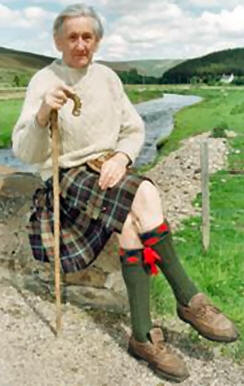
Expert on tartans who debunked shortbread-tin whimsy and
conducted careful experiments in dyeing and weaving
Jamie Scarlett was a world authority on
tartans and the foremost designer of tartans of the 20th century. By his
careful research and prolific writing he did much to dispel the cosy,
cottage industry image of tartan production and to have it recognised for
the massive commercial enterprise that it actually is.
Always scornful of what he called
“shortbread-tin tourism”, he did much to rescue the image of tartan for the
21st century. Brian Wilton, director of the Scottish Tartans Authority and
who collaborated with him on the first film to debunk the myths and legends
of tartan, called him “a towering figure in tartan academia”.
As for the physical making of tartan
cloth, Scarlett was blunt: “Tartan weaving should have been recognised as a
Highland art form long ago.”
He wrote a score of books on tartans,
in addition to dozens of articles, papers and lectures. His Tartan Weaver’s
Guide (1985), a bestselling minor classic, established him as the leading
light of the tartan scene. For The Tartans of the Clan Chattan, his
pioneering work on the complex subject of setts (tartan patterns) of a clan
confederation, he was elected vice-president of the Clan Chattan
Association.
He was a painstaking and avowedly
sceptical researcher — “A researcher needs both to have an inquiring mind,
and the ability to smell a rat,” he told one audience, adding: “I never
believe anything I see in print, even though I wrote it myself.” This point
he illustrated with a nonsense saying that he coined — “When the Slochd is
blochd, Drumochter is blochter” (a reference to two notorious points on the
A9 in winter) — and had seen some years later published in a magazine as an
example of “ancient Highland folklore”.
One preconceived notion about Highland
dress which he most famously debunked — and for which some authorities have
never forgiven him — is that of the standard tourist demonstration of the
putting of the feilidh mor, or great kilt. Tradition held that to wear it, a
Highlander would lay his broad leather belt on the ground and then put the
18ft by 5ft plaid on top of it, bunching the lower end into rough pleats,
and lie down so that the bottom edge reached between the middle of thigh and
knee. The remainder would be gathered around arms and torso and held in
place by a brooch at the shoulder.
Scarlett thought it impossible that
such an amount of cloth could ever have been manoeuvred within a tiny croft
house, with the wearer having to lie down on the pre-folded cloth before
belting it around him. Nor, he argued, would such a garment be likely to be
donned outside, given the mud and sharn of the average cottar close.
He based all of his writings on
painstaking practical research. He gathered the fungi and lichens for dyeing
the yarn he spun himself. He experimented with stains and colours, matching
and contrasting thread counts. He wove on looms he made himself. At his home
in Moy, Inverness-shire, watched by his cats Qwerty and Twinkle, he would
work up an experimental length on a tabletop loom in his kitchen before
creating full-length material on a hand loom in an outhouse.
A habitual kilt wearer himself, he
designed about 30 setts. Some, such as Border Bell, were for specific names,
and others, such as Boyd, were for the family headed by Patrick Boyd, Earl
of Glasgow. He also contributed widely to the production of chiefly,
personal, clan, family, sept, national, county, territorial, district,
estate, foreign, commemorative, corporate, fashion, private, institutional,
sporting, club, society and educational tartans including Amnesty
International, the Royal College of Radiographers, American Bicentennial and
Furman University in South Carolina.
For his marriage in 1972 to Meta (née
MacBean), he designed and personally wove a tartan for her wedding gown
called Meta MacBean.
Tall and silver-haired, he would hide
his dry wit with what appeared on first acquaintance to be a visage of the
stern verging on the dour. He described Captain Stuart Davidson, Home
Counties dweller and founder of the Scottish Tartans Society about 45 years
ago, as “the epitome of those exiled Scots of whom there are none more
Scots” and “a militant wearer of the kilt” who “looked like a tartan
hedgehog”. Scarlett’s caustic regard of someone who for whom he nevertheless
formed a great affection extended farther: “I drove his car once — it was
not something one did twice.”
It was not plain speaking but his
painstaking research habits which earned Scarlett his reputation in tartan
academia. He argued lucidly and closely, always from first principles and
practical experience. His most recent contribution was a submission to the
committee of MSPs during the consultation process for the creation of a
Scottish Tartans Register.
Born in Battersea, London and educated
at King’s School, Wandsworth, James Desmond Scarlett would when hard
pressed, admit to “some Scots ancestry, though it’s very dilute”. Flying was
his first love, and he was a member of the RAF Volunteer Reserve before the
war. He served in the RAF as an aircraft fitter from September 1939 until
February 1946. A quantity surveyor by profession, he continued his passion
for flying with a private pilot’s licence in the 1950s. It was only what he
described as “a chance encounter” in Perthshire in 1963 that he became
interested in Scotland generally and tartan in particular.
His fascination was such that within a
year he had built a hand loom and started weaving in his bedroom, hanks of
yarn hung over the banisters and kept straight by weights made from
household objects. To his mother’s chagrin, her pots and pans were indelibly
stained from his boiling up of stains and dyes. When invited to demonstrate
weaving at a show in Richmond Park, it required half a morning’s work by
Scarlett and his young siblings Ann, Margaret and John to carry the loom
downstairs.
By 1976 he had given up quantity
surveying and moved to Scotland, latterly to Moy, working full-time in
studying, collecting, researching, dyeing and weaving tartans, and earning
enough income by writing. He was appointed MBE for his tartans work.
Scarlett’s wife, Meta, predeceased him
in 2000.
James Scarlett, MBE, expert on tartans,
was born on June 4, 1920. He died on May 16, 2008, aged 87.
Email from
Brian Wilton following Jamie’s death:
|
Dear Frank,
Ian MacDonald has
passed your e-mail on to me re - I think - the address to
Jamie that I delivered at his funeral. I thought someone else had
already e-mailed that to you but I'll attach it again. I know that
you were good friends and Jamie always spoke very highly of you so
here's a bit more detail of events.
I spoke by telephone
to Jamie on the Friday before his death and he was complaining of
indigestion pains. I bullied him into getting his doctor out - he
was never keen on bothering them - and whether that happened or not
I don't know because when I rang back later, all I got was his
answering machine. I managed to track down a neighbour who had seen
an ambulance at his place around tea-time so that solved the puzzle.
Contacting the hospital later than evening I was told that he was
under investigation but was quite comfortable and might possibly be
released the next day.
Next day arrived and
the ward sister told me that when he was moved from A&E he had taken
a turn for the worse but was still chirpy and chatting away. Later
in the day I discovered that he'd gone downhill even more and I
requested the sister to pass a message to him that I was coming up
immediately (I'm about two hours away) and that he'd "bloody well
better not go anywhere!"
Whether or not that
made any difference I doubt, but when I arrived he woke up and said
"I'm in a bit of a bad way," Then he asked me "How did you get
here?" and immediately went back to sleep.
I sat with him and
about an hour later his heart monitor showed a gradual decrease
until it flat-lined at about 30 beats per minute and that was poor
Jamie gone. Peaceful, painless and in his sleep.
The service in
Inverness Cathedral was beautiful and he was buried at Kincraig
which, as I'm sure you know, was Meta's resting place. His two
sisters - Margaret and Ann - had come up from London and seemed very
happy that their big brother had such a dignified and heartfelt
send-off.
Also attached is an
excellent obituary written by Gordon Casely - one of our Governors -
which he got accepted by The Times so Jamie got
unbelievable but well-deserved national coverage!
Best wishes,
Brian |
May 28, 2008
It was a rare privilege indeed to meet Jamie Scarlett and have him design an
official tartan for Furman University. His knowledge of tartans was
exceeded only by his gracious hospitality and sterling integrity. All of us
who had the honor of knowing him and learning from him take solace in the
realization that his spirit lives on through his tartans and his writings.

David E. Shi, President
Furman University
Greenville, South Carolina, USA
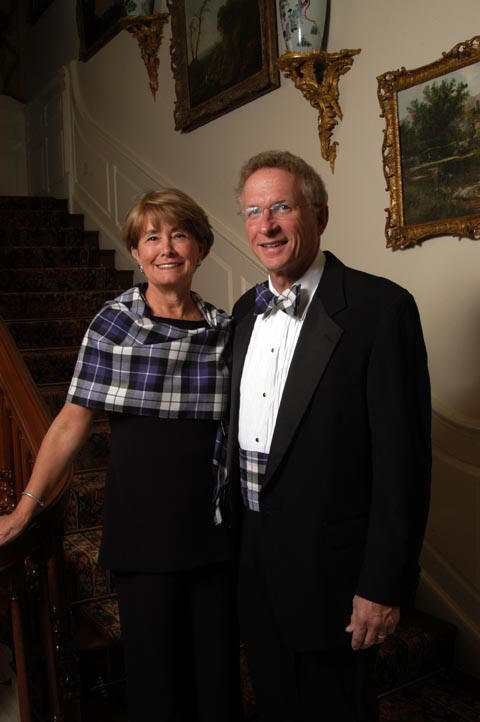
Dr Shi, president of Furman University, and his
wife Susan, in Black Tie dress
with the Furman University Tartan that Jamie Scarlet designed for Furman. |
